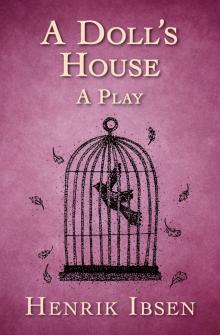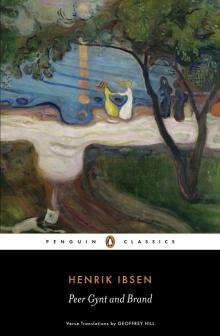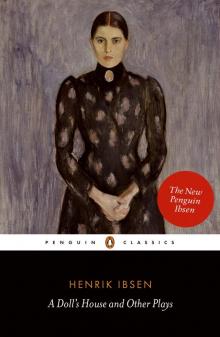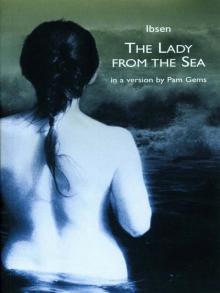- Home
- Henrik Ibsen
Peer Gynt and Brand
Peer Gynt and Brand Read online
Henrik Ibsen
* * *
PEER GYNT AND BRAND
In versions by
GEOFFREY HILL
Introduced by
JANET GARTON
General Editor
TORE REM
Contents
A Note on the Text
Introduction
BRAND
PEER GYNT
Afterword: Translating and Recreating Ibsen: An Interview with Geoffrey Hill
Notes
Chronology
Further Reading
Follow Penguin
PENGUIN CLASSICS
PEER GYNT AND BRAND
HENRIK IBSEN (1828–1906) is often called ‘the Father of Modern Drama’. He was born in the small Norwegian town of Skien and made his debut as a writer with the three-act play Catilina (1850). Between 1851 and 1864 he was artistic director and consultant for theatres in Bergen and Christiania (later spelled Kristiania; now Oslo), and contributed strongly to a renewal of Norwegian drama, writing plays such as The Vikings at Helgeland (1858), Love’s Comedy (1862) and The Pretenders (1863). In 1864 he left Norway on a state travel stipend and went to Rome with his wife Suzannah. This marked the beginning of what would become a 27-year-long voluntary exile in Italy and Germany. Ibsen experienced a critical and commercial success with the verse drama Brand (1866); this was followed by his other great drama in verse, Peer Gynt (1867), the prose play The League of Youth (1869) and his colossal Emperor and Galilean (1873), a ‘world-historical play’, also in prose. The next decisive turn in Ibsen’s career came with Pillars of the Community (1877), the beginning of the twelve-play cycle of modern prose plays. Here he turned his attention to contemporary bourgeois life, rejecting verse for good. This cycle would include A Doll’s House (1879), Ghosts (1881), An Enemy of the People (1882), The Wild Duck (1884), Rosmersholm (1886), The Lady from the Sea (1888), Hedda Gabler (1890), The Master Builder (1892), Little Eyolf (1894), John Gabriel Borkman (1896) and, finally, When We Dead Awaken (1899). By the time Ibsen returned to Norway in 1891, he had acquired Europe-wide fame, and his plays soon entered the canons of world literature and drama. Following a series of strokes, he died at home in Kristiania at the age of seventy-eight.
GEOFFREY HILL, the son of a police constable, was born in Worcestershire in 1932. He was educated at Bromsgrove County High School and at Keble College, Oxford. After teaching for more than thirty years in England, first at Leeds and subsequently at Cambridge, he became Professor of Literature and Religion at Boston University in Massachusetts, where he was also founding co-director of the Editorial Institute. In 2010 he was elected Professor of Poetry at the University of Oxford, and in 2012 he was knighted. His collection Broken Hierarchies: Poems 1952–2012 was published in 2014.
JANET GARTON is Emeritus Professor of European Literature at the University of East Anglia, Norwich. She has published a number of books on Scandinavian literature, including Norwegian Women’s Writing (1993), the edited letters of Amalie and Erik Skram (3 vols., 2002) and a biography of Amalie Skram, Amalie – et forfatterliv (2011). She is a director of Norvik Press and has translated several works of Norwegian and Danish literature, including Knut Faldbakken: The Sleeping Prince (1988), Bjørg Vik: An Aquarium of Women (1987), Kirsten Thorup: The God of Chance (2013) and Johan Borgen: Little Lord (forthcoming).
TORE REM is Professor of British Literature at the Department of Literature, Area Studies and European Languages, the University of Oslo. He has published extensively on British and Scandinavian nineteenth-century literature and drama, including the books Dickens, Melodrama and the Parodic Imagination (2002) and Henry Gibson/Henrik Ibsen (2006), as well as on life writing, the history of the book, reception studies and world literature. Rem has been Christensen Visiting Fellow at St Catherine’s College, Oxford, was director of the board of the Centre for Ibsen Studies and is a member of the Norwegian Academy of Science and Letters.
A Note on the Text
This Penguin edition of Peer Gynt is the first English-language edition based on the new historical-critical edition of Henrik Ibsen’s work, Henrik Ibsens Skrifter (2005–10) (HIS). The digital edition (HISe) is available at http://www.ibsen.uio.no/forside.xhtml. The texts of HIS are based on Ibsen’s first editions.
Introduction
Nordic Frustrations
The series of twelve prose dramas for which Ibsen is generally known outside Norway were all written quite late in his life, from 1877 (Pillars of the Community) to 1899 (When We Dead Awaken). By 1877 he was forty-nine years old and already had over half of his literary production behind him; his first play, Catilina, was published in 1850, and he went on to publish a further fourteen plays as well as a volume of poetry over the following twenty-five years. It was during this period that he acquired the skills of writing for the stage which he was to use with such assurance in his mature works. By the time he published Brand and Peer Gynt, in 1866 and 1867 respectively, he had written and seen staged several of his own plays.
Henrik Ibsen had an inauspicious beginning as a writer; the son of a bankrupt father, he had left school at fifteen to start work as an apothecary’s apprentice. Largely self-taught, he failed his university entrance exams, but persevered in writing plays and managed to attract the attention of the new Norwegian Theatre in Bergen, which had been set up by the world-famous violinist and entrepreneur Ole Bull. Here Ibsen was appointed ‘dramatic author’ in 1851, a post he held for six years; this was followed by five years at the Norwegian Theatre in Christiania (Oslo). During this time it was his responsibility to write plays for performance at the two theatres, as well as directing plays by other authors. In the tradition of the time, his plays were written largely in verse, and in line with the National Romantic ideals fostered by the growing movement for independence they often took their inspiration from earlier Norwegian history, such as Lady Inger of Ostrat (1855), about sixteenth-century Dano-Norwegian dynastic battles, and The Vikings at Helgeland (1858), which dramatized the tenth-century conflict between the warriors Sigurd and Gunnar and their ill-matched wives Dagny and Hjørdis. The plays he was directing were often foreign ones imported as light entertainment, largely French comedies by dramatists such as Eugène Scribe or Danish ones by Ludvig Holberg, from which he learned much about the techniques of stagecraft.
His tenure as contracted dramatic author and theatre director was not a happy one, however; his own plays had variable success, and he was not gifted as an entrepreneur or as an administrator. In Christiania things went from bad to worse, as the theatre’s finances became precarious. Ibsen was attacked in the press for his bad management and reacted with apathy; his productions failed to arouse any interest, and for a few years he found himself unable to write any more plays. To some extent he was also a scapegoat for the theatre board’s extravagance in incurring debts for a programme of rebuilding which far exceeded the theatre’s income. The final result was that the theatre went bankrupt in June 1862, and Ibsen was fired. For the next couple of years he had no regular income. He applied to the government for an annual stipend as an author and was refused, although the only other two applicants, his friend and dramatic rival Bjørnstjerne Bjørnson and the poet Aasmund Olavsson Vinje, were awarded grants. Release from the theatrical grind did allow him to write his best two plays so far, Love’s Comedy (1862) and The Pretenders (1863). The former, a comedy of contemporary manners in verse, was due to be performed by the Christiania Theatre, but then withdrawn because of the theatre’s financial problems. The latter was a historical play, taking as its subject the fourteenth-century struggle for power between Earl Skule and King Haakon, often interpreted as a dramatization of the power struggle between the self-doubting Ibsen and the supremely confident B
jørnson. It was also Ibsen’s first attempt at writing a play in modern colloquial prose. He directed it himself at the Christiania Theatre in January 1864, and this time he had a critical and popular success. But by now Ibsen had already decided to leave Norway.
The mid nineteenth century was a turbulent time politically for the three mainland countries of Scandinavia, and links between Norway, Denmark and Sweden were much closer then than now. Norway had been ruled by Denmark until 1814 and was released from that dependence only to be constrained by European political negotiations to become the junior partner in a union with Sweden, which lasted until 1905. Ties to Denmark were still particularly close during Ibsen’s lifetime. Christiania was a small provincial town, and Copenhagen a cultural centre for writers and artists; many moved there, and most leading Norwegian authors came, during the second half of the century, to be published in Denmark. A movement for the promotion of closer political and cultural ties between the countries, called Scandinavianism, had attracted support from academics and politicians since the 1840s, and Ibsen was an ardent supporter. King Karl XV of Sweden-Norway and his ministers had made assurances of mutual self-defence and military aid. Thus when Denmark was threatened by Prussian invasion from the south in 1863–4, Ibsen was in no doubt that Norwegians at least would take up arms for their ‘brother in need’, as he declared in his poem of that name.1 The fact that it did not happen was a bitter blow and strengthened his determination to turn his back on what he saw as his pusillanimous native land.
Money, however, was still a problem, as it had been for many years, and Ibsen now had a wife and small son to support. He managed to obtain a travel grant of 400 speciedaler from the government for a study trip to Rome and Paris, two-thirds of what he had asked for, which was then supplemented by a further 700 speciedaler raised by the ever-generous Bjørnson. The latter demonstrated an unfailing readiness to support his less successful colleague both in word and in deed.
At the beginning of April 1864 Ibsen left Christiania for a sojourn abroad which would last for twenty-seven years before he finally returned home to settle in Norway. While he was in Copenhagen on the way south the news came of the final defeat of the Danes by the Prussians at Dybbøl and the surrender of two-fifths of Danish territory. When he reached Berlin in May he saw the Danish cannon paraded in triumph through the streets, a sight which sharpened his dismay at what he saw as his country’s failure. Finally, on 9 May he crossed the Alps into Italy, reaching Rome in the middle of June. Emerging from the tunnel into the sunlight of the south was a revelation which he recalled vividly several decades later:
Over the high mountains the clouds hung like great dark curtains, and beneath these we drove through the tunnel and suddenly found ourselves at Mira Mara, where the beauty of the South, a marvellously brilliant light shining like white marble, suddenly opened before me and coloured all my later work, even if not all of it was beautiful.2
The Light of the South
It may seem at first sight as if the creative floodgates opened when Ibsen reached Rome; after his arrival in June 1864, his two ground-breaking poetic dramas were soon published, Brand in 1866 and Peer Gynt in 1867. Inspiration did not flow as easily as that, however. Despite his enthusiasm for the newly unified Italy and the sense of creative and personal liberation he experienced on leaving Norway, he struggled to find both a form in which to express his frustration at recent events and a peaceful environment in which to work. It was not until he moved to the countryside in the summer of 1864 that he started to write – and then he began work, not on a drama, but on a long narrative poem, usually referred to as the ‘Epic Brand’.3
This poem, which exists in differing variants, contains much of the same material as the first two acts of the later play: the meeting between Einar, a fair-haired boy from a productive farm and a happy family, and the darker Brand, who grew up in poverty and strife in a narrow valley to the north; the triangle Einar–Brand–Agnes, in which Agnes feels compelled to abandon the joyful celebration of life with Einar in order to follow the harsh demands of Brand’s calling; the contrast between the little church in the valley and the Ice Church in the mountains, to which Brand is enticed by a deranged gypsy girl. It begins with the poem ‘To My Fellows in Guilt’, which addresses more directly than the later play the ignominious failure of Norway’s delusions of greatness and the poet’s shame at having fostered the illusion. It is written in iambic pentameters, in eight-line stanzas with regular rhymes – a more rigid form than the freer metre he later adopted.
It soon became apparent to Ibsen that the form he had chosen for his ideas was not working. He struggled with it for a year in increasing frustration, from the summer of 1864 to the summer of 1865, before he finally abandoned it. As he later described it in a letter to Bjørnson, the new shape of the work came to him in a moment of inspiration: ‘Then one day I went into St Peter’s Basilica – I was in Rome on some business – and there all at once it came to me, a strong and clear form for what I wanted to say.’4 Then the floodgates really did open, and Ibsen completed his new play in only four months, finishing it in mid-November. And, after having failed to attract any commercial interest with most of his earlier plays, with this play at last he found a supportive and influential publisher: Frederik V. Hegel, head of the Copenhagen-based firm of Gyldendal, publisher of many of Scandinavia’s leading writers. Hegel took the play on the recommendation of the indefatigable Bjørnson, and, after some delay caused by missing letters and misunderstandings, Brand was published in March 1866.
The play was an immediate bestseller, appearing in four editions in the first year and accruing royalties which provided Ibsen with financial security for the first time in his life. It was also a critical success across Scandinavia, enthused over by literary arbiters and by other writers – although there were some reservations about its transgression of accepted aesthetic norms. It was not staged, and it was not intended to be staged; it is subtitled ‘A dramatic poem’ and was read as a work of poetry. The mutually beneficial working relationship with Gyldendal was to continue for the rest of Ibsen’s life.
‘After Brand, Peer Gynt followed as it were of its own accord,’ declared Ibsen in a letter from 1870.5 This is a truth with modifications. For some time after finishing the earlier play, Ibsen was not sure what he was going to write next. The delay in the publication of Brand made it difficult to settle to a new work, and he considered various different projects, including a historical drama about Emperor Julian, to which he was to return years later and which would eventually become the ambitious double drama Emperor and Galilean (1873). Finally, in January 1867 Ibsen could inform Hegel that he had started work on another long dramatic poem ‘whose protagonist will be one of the Norwegian peasantry’s half mythical folk-tale characters from more recent times’.6 He had hoped to have it ready by the summer, though in the event it took him nine months to write; the last two acts had ballooned out of all proportion to the first three. He sent it to Hegel piecemeal as the various sections were ready, finishing with Act Five in October 1867, so that the book could be published – as were all his later plays – in time for the Christmas market.
This new drama was eagerly awaited after the sensation of Brand and was snapped up in the bookshops; two editions were printed in the first month. Critical acclaim was led by Bjørnson, who welcomed the play as a hard-hitting and uproariously funny satire of Norwegian self-righteousness – although he also found it a little self-indulgent. Others had difficulties with the unconventional form of the drama, particularly the influential Danish critic Clemens Petersen, who found that neither Brand nor Peer Gynt could be called ‘properly poetry’.7 (Peer Gynt, like Brand, was subtitled ‘a dramatic poem’.) Ibsen, never one to take criticism lying down, retorted forthwith to Bjørnson that Peer Gynt was poetry – ‘or if it is not, then it will become so. The concept of poetry in our country, in Norway, will come to adapt itself to my work.’8
Ibsen and his family stayed in Italy for four ye
ars, and Brand and Peer Gynt in different ways bear traces of that time. Living outside Norway meant that Ibsen could look back at Norway, as he was to do in many of his later plays, with a clearer sense of its challenges and its limitations, and of how his own views had been coloured by his early environment. In May 1868 he and his family left Italy, finally settling in Dresden in October, where they were to remain for the next six and a half years.
Brand
This ‘cathedral of a play’, ‘the most powerful drama of ideas in the whole of Scandinavian literature’, is dominated by the towering central figure, who is present in nearly every scene.9 Both charismatic and forbidding, Brand demands absolute and unwavering commitment in those around him as he does in himself and finds it as difficult as anyone else to carry his ideal unscathed through the vicissitudes of life.
It is not hard to find the germ of the character and the ideas in the play in recent international events. One oft-cited model for Brand is the young Norwegian theologian Christopher Bruun, who had taken seriously the ideals of Nordic brotherhood and was one of very few Norwegian and Swedish volunteers who fought beside the Danes at Dybbøl. He spent the winter of 1864–5 in Rome and had frequent conversations with Ibsen. Brand’s scorn for fine but empty promises is Bruun’s own, and several of the representatives of authority in the play – the mayor, the schoolmaster, the sexton – are targets for the author’s indignation at hollow political rhetoric and hypocritical self-interest. The harshness of Brand’s indictments might also owe something to some stirrings of bad conscience on Ibsen’s part; after all, he had not volunteered to fight alongside his brothers either. The title of the poem ‘To My Fellows in Guilt’ (‘Til mine medskyldige’) means literally ‘to those guilty with me’.

 A Doll's House
A Doll's House Peer Gynt and Brand
Peer Gynt and Brand The Master Builder and Other Plays
The Master Builder and Other Plays A Doll's House and Other Plays (Penguin)
A Doll's House and Other Plays (Penguin) The Lady from the Sea
The Lady from the Sea